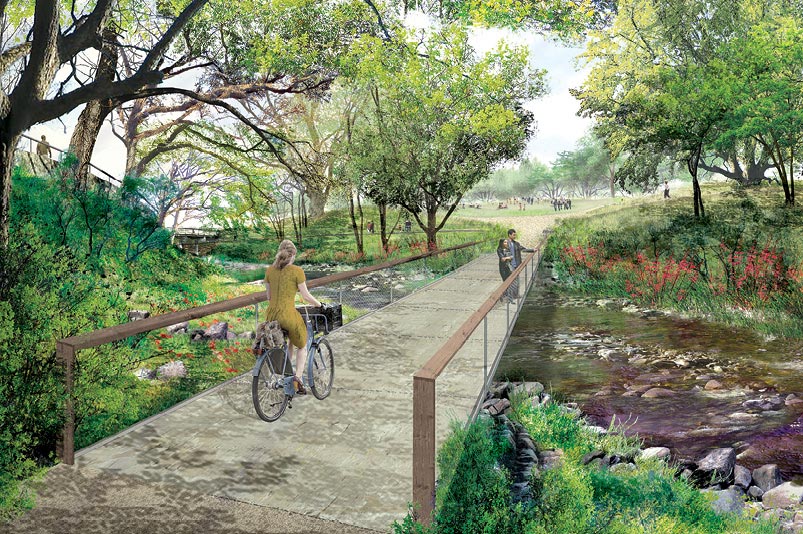Waller Creek Rising

Pedestrians will be able to get up close and personal with the restored Waller Creek ecosystem in areas like Palm Park. RENDERING Michael Van Valkenburgh Associates
WHEN EDWIN WALLER ARRIVED IN AUSTIN in 1839 to draft a plan for the city, his future eponymous creek was still a wild Central Texas waterway, cutting through a landscape of oak and juniper savanna before reaching the Colorado River. Today, Waller Creek is squeezed between the eastern edge of downtown Austin and Interstate 35, and it is not what it used to be. A walk along the narrow creek reveals night herons and sunfish but also concrete, garbage, invasive species and steep banks sheared by intermittent flash floods.
That’s all about to change, as a multimillion-dollar project led by the Waller Creek Conservancy and the City of Austin transforms the moribund creek into a pulsing artery of nature and human activity. An enormous underground tunnel now diverts floodwater into Lady Bird Lake, protecting surrounding property. And a recirculating pump system helps maintain relatively natural water levels. These recently completed engineering feats mean Waller Creek is poised to become a vibrant chain of parks for tourists and locals alike.
“We have the opportunity to create a new kind of public space for Austin – a beautiful corridor of nature in the middle of the city that invites people to contemplate, congregate and celebrate,” says Peter Mullan, CEO of the Conservancy.
Wildflower Center ecologists have been providing plant and restoration expertise as part of a project team overseen by Michael Van Valkenburgh Associates (MVVA) Inc.
“With this project, we have an opportunity to both enhance the ecology of the creek and make it more accessible to people,” says Michelle Bertelsen, a Center ecologist. “This is Austin growing in a way that I’m really excited about.”
In December 2015, project collaborators released the Creek Corridor Framework Plan that provides a cohesive development guide for individual parks and development projects as they come online over the years. Bertelsen and other Center staff helped to set design priorities so that the landscapes reflect Central Texas ecosystems. Some of the landscapes will require preservation, others need restoration and still others will require complete reconstruction.
“It’s interesting because we aren’t trying to bring this back to a pristine, predevelopment ecosystem,” says Bertelsen. “We will use native species, but it’s an urban creek and the plants we choose will have to handle that new reality.”
The first projects to move forward are the Lattice and Palm Park projects at the mouth of Waller Creek and Waterloo Park located 1.5 miles upstream. Center staff are working with MVVA, with whom they worked on the Bush Presidential Center in Dallas, on plant recommendations, construction oversight and a long-term maintenance plan.

